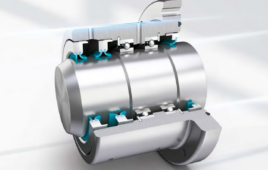Rio de Janeiro’s endless beaches and lush tropical forest will be a photographer’s dream during the 2016 Olympics. But zoom in on the likes of once-pristine Guanabara Bay, and the picture is of household trash and raw sewage.
In the neon green waters around the site of the future Olympic Park, the average fecal pollution rate is 78 times that of the Brazilian government’s “satisfactory” limit — and 195 times the level considered safe in the U.S. Nearly 70 percent of Rio’s sewage goes untreated, meaning runoff from its many slums and poor neighborhoods drain into waters soon to host some of the world’s best athletes.
Unless Brazil makes headway in cleaning up its waters, experts warn the Summer Games could pose health risks to athletes and mar what officials hope will be a global showcase event. Instead of the soaring vistas of Sugarloaf Mountain, the world could instead see old couches in the bay and tons of dead fish floating atop a city lake.
Rio’s Olympic committee has pledged in writing that the pollution problems will be fixed, and many had hoped the Olympics would force authorities to tackle decades of neglect and poor planning that have blighted waterways.
Leonardo Gryner, chief operating officer of Rio’s organizing committee, has acknowledged the extent of the water quality problem. But he said projects were “well advanced” to make good on the city’s commitment to reduce 80 percent of the pollution flowing into the bay, where sailing and wind surfing events are to be held.
With just 2 ½ years to go before the games, however, experts say cleanup efforts are moving at a snail’s pace and haven’t significantly improved capacity in sewage treatment plants or hooked up more of the city’s 6 million residents.
“The high concentrations of untreated human waste means there are pathogens and disease-causing organisms in the water,” said Dr. Casey Brown, a professor of civil and environmental engineering at the University of Massachusetts Amherst. “If I were going to take part, I would make sure all my shots were up to date.”
Tests show the problems are still severe in several of the competition venues.
At the site of the Olympic Park, in the Barra neighborhood, untreated human waste flows from nearby condominiums and sprawling shantytowns, presenting an immediate health hazard, according to Rio de Janeiro Environment Ministry documents examined by The Associated Press. Pollution fills many of the waterways in Barra, where about half the Olympic events will be held.
In the waters just off Copacabana beach, the measurement of fecal coliform bacteria spiked to 16 times the Brazilian government’s satisfactory level as recently as three weeks ago, bad news for the marathon swimmers and triathletes set to compete there.
The Lagoa Rodrigo de Freitas often experiences huge fish die-offs that leave its surface blanketed with tons of dead fish. Rowing and canoeing events are set to take place on the briny lake.
Another entrenched problem is the 148-square-mile (383-square-kilometer) Guanabara Bay, where the only exit for foul, polluted waters is through a narrow opening onto the Atlantic Ocean. Home to a thriving artisanal fishing industry and popular palm-lined beaches as recently as the late-1970s, the bay has become a watery dump for waste from shipyards and two commercial ports as well as leachate, the toxic byproduct of mountains of rotting trash sitting at what was South America’s largest landfill until its closure last year.
At low tide, household trash, including old washing machines and soggy couches, float atop vast islands of accumulated sewage and sediment. Experts say it’s even possible that vessels plowing through the water at speeds of more than 20 mph during Olympic events could collide with floating detritus below the surface.
Ecology professor Ricardo Freitas knows all too well the risks. As part of his work with a conservation group trying to save Rio’s besieged urban caimans, Freitas regularly wades in and wrestles the reptiles onto shore or into boats to tag them.
“There’s no way to work in these waters, where you are literally neck deep in feces in some places, and not be afraid of the health effects,” Freitas said, adding that on the one occasion when he was bitten by a caiman, the small wound got severely infected because of the contaminated water. “Show me the Olympic athlete who’s going to have the courage to get into waters like these.”
It’s not clear what consequences there might be if Rio doesn’t clean up its waterways, but this isn’t the first time the Olympics have faced steep environmental challenges. The Swiss-based International Olympic Committee took much flak during the 2008 Beijing Summer Games, when the city failed to clean up its smoggy air in the event’s initial days. This year, similar concerns have been raised about the Winter Olympics in Sochi, Russia, with crews dumping concrete construction waste and other trash in rivers, protected forests and other sensitive zones.
Pollution problems at those sites may be a key reason why the committee in September chose Tokyo for the 2020 Olympics. Japan had billed itself as a “safe pair of hands.”
The Japanese government helped fund an effort to clean up Rio’s Guanabara Bay starting in 1992, but two decades later there’s little to show for the more than $700 million spent. At least five sewage treatment plants were built with the money, but most run under capacity because they haven’t been fully linked to the collection pipes. One plant, in the gritty suburb of Sao Goncalo, across the bay from Rio, has yet to treat a drop of sewage.
Some critics say corruption was largely responsible for the failure of the Japanese-funded effort, which grew out of the United Nation’s Eco-92 conference in Rio. But Gerson Serva, coordinator for the state’s latest bay cleanup program, said the real culprit was lack of planning.
“The scale of what needs to be done was so great that they started to try to tackle all the fronts, which meant that many things were left half done,” Serva said. “Rio has historically had a culture of poor planning in the realm of basic sanitation.”
While water quality varies depending on the exact location, the state’s INEA environmental agency has classified nearly all the 13 bayside beaches it monitors as “terrible” for 12 years running due to high levels of fecal bacteria. Exposure to such bacteria can cause gastro-intestinal illnesses like cramps, diarrhea, dysentery and cholera. Pollution data readings since 2000 provided by INAE show consistently high readings in Guanabara and the waters of Barra.
With other measures coming up short, authorities are pinning their cleanup efforts on the construction of “river treatment units,” or RTUs, which are facilities built over rivers that filter most of the trash and human waste before the waters pour into the bay. Costly to operate because they rely on a fleet of trucks to shuttle the collected waste to landfills, RTUs are seen by environmentalists as a stopgap measure that fails to prevent sewage and trash from being dumped, only cleaning them up afterward.
Rio officials are also counting on a fleet of 10 garbage boats that will ply the waters of the bay, filtering out garbage and potentially dangerous larger debris.
The most visible cleanup measures are “eco-barriers,” chains of plastic buoys strung across rivers that block some of trash.
Mario Moscatelli, a biologist who oversees the reforestation of mangrove forests along the bay, said he fears that even if the bay is cleaned up, the state will let it deteriorate after the athletes go home.
“If it’s hard to get authorities to care about the Guanabara Bay now, with the Olympics looming,” he said, “imagine what it will be like once they’re over.”
___
Associated Press writers Stephen Wade and Bradley Brooks contributed to this report.
Filed Under: Industrial automation




